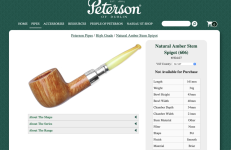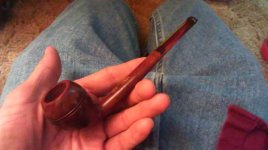Right. But amber is tens of millions of years old, so what's 150 years on top of that?It is AGE that makes it brittle and glasslike. Between 100 and 150 years from production to today for most pipe stems.
Green Amber?
- Thread starter Winnipeger
- Start date
You are using an out of date browser. It may not display this or other websites correctly.
You should upgrade or use an alternative browser.
You should upgrade or use an alternative browser.
SmokingPipes.com Updates
Watch for Updates Twice a Week
So to hear, they are brittle use supreme caution, it’s just bullshit. Utter bullshit.
Imma gonna guess there's more happening here than meets the eye, somehow.
Because Chuck Gray was the top meer and amber repair guy on Earth---as in, was the first choice to fix high-dollar historical stuff for museums---and he described to me in considerable detail on nemerous occasions how treacherously snappy it could be.
What I meant was 100+ yo Amber-stemmed pipesWikipedia:
Baltic amber is found as irregular nodules in marine glauconitic sand, known as blue earth, occurring in Upper Eocene strata of Sambia in Prussia.Eocene Epoch is a geological epoch that lasted from about 56 to 33.9 million years ago (mya).I don't know that pipe stems being 100+ years old is of any significance wrt its fragility when the material it's made from is tens of millions of years old to begin with...
...Then again, maybe being exposed to heat weakens it(?)
Such old relics come in a vastly differing condition. From immaculately kept ones reposing in their original cases to ones kept higgledy-spiggledy in cardboard cartons or drawers.
Right. But amber is tens of millions of years old, so what's 150 years on top of that?
It was deep underground that long as a block.
The 150 years is after being shaved down dramatically, exposed to light, etc.
Very different conditions.
It was deep underground that long as a block.
The 150 years after being shaved down dramatically, exposed to light, and so forth has a drying effect.
PS --- This forum's edit function occasionally sucks huge amounts of ass. Just sayin'. lol (This post was supposed to have been a clarification of the post above it)
Last edited:
Agreed. @ashdigger 's posts on the WAYS thread piqued my curiosity in the first place. Cool to see these old relics and to know they're still being put to their intended use.A proper pipe porn on this thread.
It must have to do with the amount of heat exposure. Apparently you can burn amber as an incense so it's obviously not impervious to heat. Maybe @ashdigger 's pipes were well loved by their original owners and not overly abused. They're some beautiful specimens.Imma gonna guess there's more happening here than meets the eye, somehow.
Because Chuck Gray was the top meer and amber repair guy on Earth---as in, was the first choice to fix high-dollar historical stuff for museums---and he described to me in considerable detail on nemerous occasions how treacherously snappy it could be.
It must have to do with the amount of heat exposure. Apparently you can burn amber as an incense so it's obviously not impervious to heat. Maybe @ashdigger 's pipes were well loved by their original owners and not overly abused. They're some beautiful specimens.
Another possibility:
In amber's heyday there was no shortage of amBROID stems. (Amber dust & glue made into a composite)
It was cloudy, not translucent, but so was a lot of solid amber.
Anyway, the composite varieties get thrown into the mix by many (most?) people who can't tell the difference, which naturally confuses the things when it comes to properties of the material.
Sure. Ambroid would have a much more brittle structure than genuine amber. Genuine amber that I've seen usually has at least a few inclusions or bubbles in it. The cloudy stuff has millions of micro bubbles in dispersion, but it's still genuine amber. I imagine a cloudy looking ambroid stem would be really hard to tell apart from the real deal on visual inspection alone.Another possibility:
In amber's heyday there was no shortage of amBROID stems. (Amber dust & glue made into a composite)
It was cloudy, not translucent, but so was a lot of solid amber.
Anyway, the composite varieties get thrown into the mix by many (most?) people who can't tell the difference, which naturally confuses the durability issue.
Regular meerschaum smokers really don't treat their pipes with delicacy. That one doesn't have a heel making it a belge.meaning without delicacy worries
Extended exposure to UV and harsh temperature changes will do it as well.It is AGE that makes it brittle and glasslike.
Thanks for all the input guys. Doesn't definitively answer my question, but super interesting nonetheless.
A little background:
When I was in the Baltic in 2006 I was working onboard a cruise liner. We sailed from Harwich in Essex, England, through the Baltic as far East as St. Petersburg, Russia with many stops along the way. There was a vendor onboard selling a large variety of amber jewelry, Fabergé-style eggs and the like. They explained all the different varieties of amber to me and what to look for. I also went to a large shop in Tallinn, Estonia that specialized in amber. They had some fabulous specimens. I saw a lot of green amber, and bought some too.
I'm far from being an expert, but I notice that all of the stems in @ashdigger 's photos have some degree of variegation. That looks like genuine amber because it's not perfect. The photo @Chasing Embers posted above of a transparent stem looks too perfect, especially considering how large a piece you would need to make a stem. Just my two cents. Of course you can test whether or not it's genuine, and if I'm wrong, no harm, no foul.
A little background:
When I was in the Baltic in 2006 I was working onboard a cruise liner. We sailed from Harwich in Essex, England, through the Baltic as far East as St. Petersburg, Russia with many stops along the way. There was a vendor onboard selling a large variety of amber jewelry, Fabergé-style eggs and the like. They explained all the different varieties of amber to me and what to look for. I also went to a large shop in Tallinn, Estonia that specialized in amber. They had some fabulous specimens. I saw a lot of green amber, and bought some too.
I'm far from being an expert, but I notice that all of the stems in @ashdigger 's photos have some degree of variegation. That looks like genuine amber because it's not perfect. The photo @Chasing Embers posted above of a transparent stem looks too perfect, especially considering how large a piece you would need to make a stem. Just my two cents. Of course you can test whether or not it's genuine, and if I'm wrong, no harm, no foul.
Well I Never Knew This Little Amber Fact. :: General Pipe Smoking Discussion - https://pipesmagazine.com/forums/threads/well-i-never-knew-this-little-amber-fact.57759/Came off of this fellow. A pre 1920 KB&B with an orific airway.
View attachment 172408View attachment 172409
It passed the salt water and static tests.
Who knew the answer to all our questions was to be found in this very forum. The amber used to make pipe stems was genuine amber, melted into slabs. It would pass the test. But green amber slabs wouldn't have been a thing, because orange-yellow amber is more common and it was an industrial process.
Thanks @mawnansmiff
Last edited:
I wonder if you can get it to exude a pine-like smell by rubbing it vigorously?It passed the salt water and static tests.
[That's what she said.]
This group here are a mixture of amber stemmed, amber-oid, modern replacement stems and a couple of original vulcanite stems from the 1920s. I posted another group of 'cutty' pipes with just amber stems the other week. If you dial through my 'What are You Smoking' posts you can see even more pipes with amber stems. Strangely enough I don't put the tape on my stems but I do keep my pipes away from extreme heat and ultra violet light and hence my preference for hard cases.


It's funny when we describe something as amber-colored we mean that it looks honey colored or yellow-orange—like an amber caution light. When I googled green amber pipe stems the closest example I could find was from a recent Peterson catalogue. One amber stem if not actually green, is at least greenish or tending toward green.

I've seen one pipe with an amber stem of mostly very cool yellow that gradated into a bit of yellow green. The amber also gradated in opacity at different points along its length. Interesting looking thing.
Green amber typically looks like this:It's funny when we describe something as amber-colored we mean that it looks honey colored or yellow-orange—like an amber caution light. When I googled green amber pipe stems the closest example I could find was from a recent Peterson catalogue. One amber stem if not actually green, is at least greenish or tending toward green.View attachment 172467













